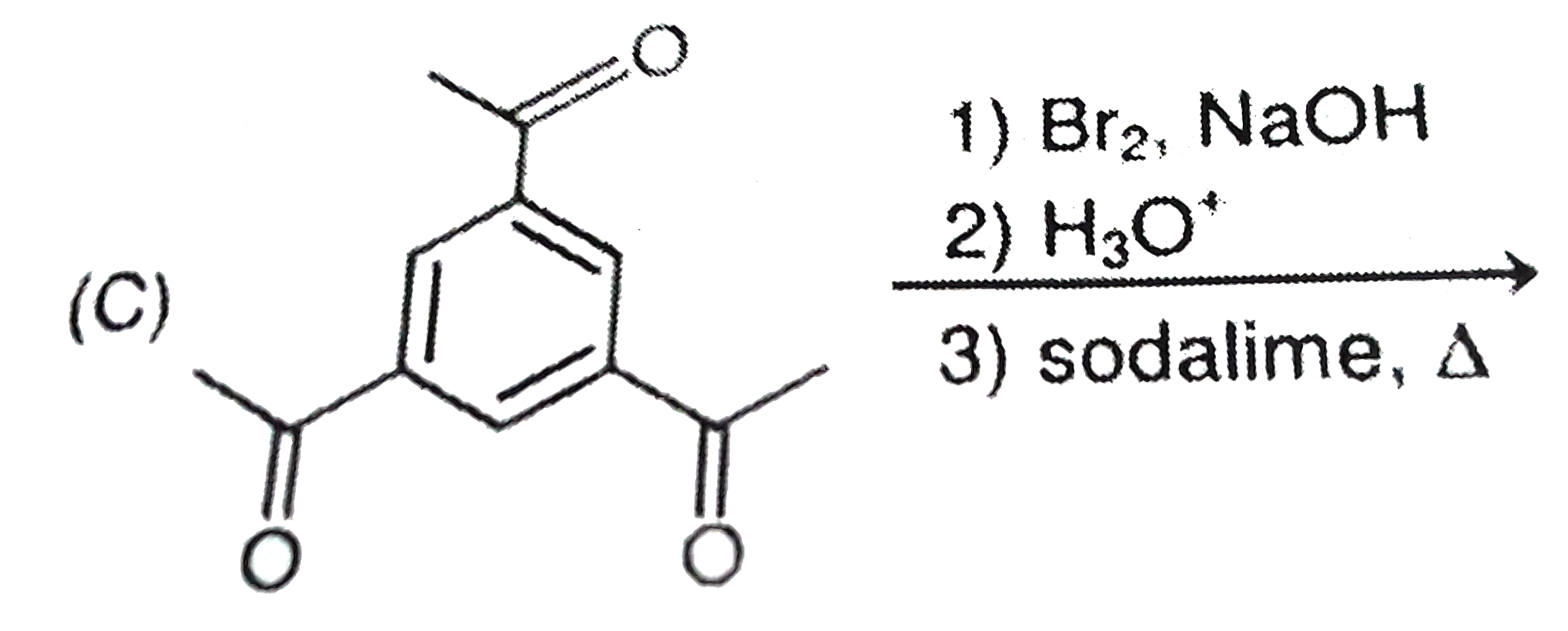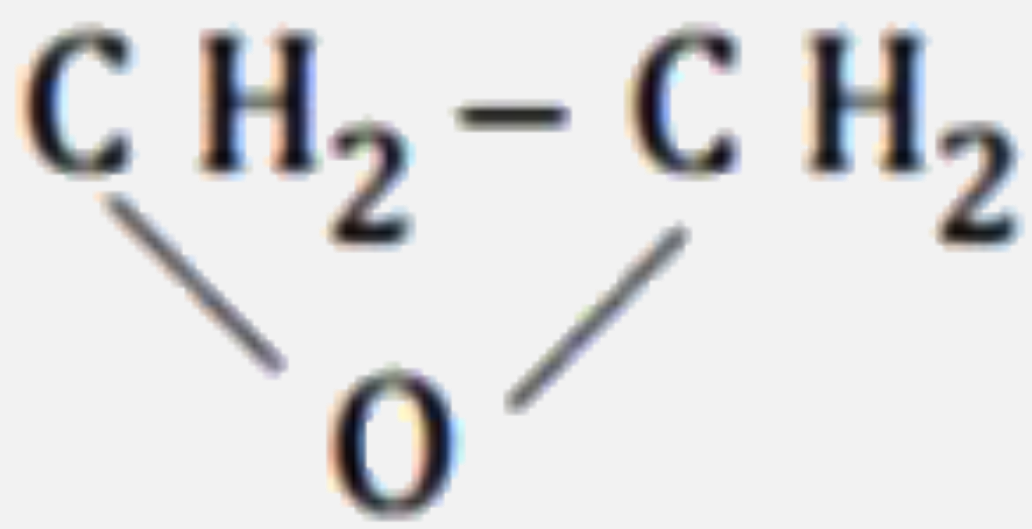The reaction(s) leading to the formation of 1, 3, 5 -trimethylbenzene is (are)




The correct Answer is:A, B, D
To determine the reactions that lead to the formation of 1,3,5-trimethylbenzene, we will analyze the provided options step by step.
1. Understanding the Structure of 1,3,5-Trimethylbenzene:
- The molecular structure of 1,3,5-trimethylbenzene consists of a benzene ring with three methyl (CH₃) groups attached at the 1st, 3rd, and 5th positions.
2. Analyzing Option A:
- Reagents: Acetone treated with concentrated H₂SO₄ and heat.
- Reaction: Three moles of acetone (CH₃COCH₃) undergo dehydration in the presence of concentrated sulfuric acid. This leads to the formation of benzene with three methyl groups at the specified positions.
- Conclusion: This reaction successfully yields 1,3,5-trimethylbenzene. (Correct)
3. Analyzing Option B:
- Reagents: Acetylene heated in an iron tube at 873 K.
- Reaction: Three moles of acetylene (C₂H₂) undergo coupling reactions when heated, leading to the formation of 1,3,5-trimethylbenzene.
- Conclusion: This reaction also yields 1,3,5-trimethylbenzene. (Correct)
4. Analyzing Option C:
- Reagents: A compound with acetyl groups at the 1st, 3rd, and 5th positions treated with Br₂ and NaOH, followed by H₃O⁺ and soda lime.
- Reaction: The haloform reaction occurs, where the acetyl groups are converted, and soda lime treatment removes CO₂. However, this does not lead to the formation of 1,3,5-trimethylbenzene.
- Conclusion: This reaction does not yield the desired product. (Incorrect)
5. Analyzing Option D:
- Reagents: A compound with aldehyde groups at the 1st, 3rd, and 5th positions treated with Zn/Hg and HCl.
- Reaction: This is a Clemmensen reduction, which converts the aldehyde groups (CHO) into methyl groups (CH₃).
- Conclusion: This reaction yields 1,3,5-trimethylbenzene. (Correct)
Final Conclusion:
The reactions that lead to the formation of 1,3,5-trimethylbenzene are found in options A, B, and D. Therefore, the correct answers are A, B, and D.
- The molecular structure of 1,3,5-trimethylbenzene consists of a benzene ring with three methyl (CH₃) groups attached at the 1st, 3rd, and 5th positions.
- Reagents: Acetone treated with concentrated H₂SO₄ and heat.
- Reaction: Three moles of acetone (CH₃COCH₃) undergo dehydration in the presence of concentrated sulfuric acid. This leads to the formation of benzene with three methyl groups at the specified positions.
- Conclusion: This reaction successfully yields 1,3,5-trimethylbenzene. (Correct)
- Reagents: Acetylene heated in an iron tube at 873 K.
- Reaction: Three moles of acetylene (C₂H₂) undergo coupling reactions when heated, leading to the formation of 1,3,5-trimethylbenzene.
- Conclusion: This reaction also yields 1,3,5-trimethylbenzene. (Correct)
- Reagents: A compound with acetyl groups at the 1st, 3rd, and 5th positions treated with Br₂ and NaOH, followed by H₃O⁺ and soda lime.
- Reaction: The haloform reaction occurs, where the acetyl groups are converted, and soda lime treatment removes CO₂. However, this does not lead to the formation of 1,3,5-trimethylbenzene.
- Conclusion: This reaction does not yield the desired product. (Incorrect)
- Reagents: A compound with aldehyde groups at the 1st, 3rd, and 5th positions treated with Zn/Hg and HCl.
- Reaction: This is a Clemmensen reduction, which converts the aldehyde groups (CHO) into methyl groups (CH₃).
- Conclusion: This reaction yields 1,3,5-trimethylbenzene. (Correct)
The reactions that lead to the formation of 1,3,5-trimethylbenzene are found in options A, B, and D. Therefore, the correct answers are A, B, and D.
Topper's Solved these Questions
- AROMATIC COMPOUNDS BOOK - RESONANCE ENGLISHCHAPTER - AROMATIC COMPOUNDS EXERCISE - PART-II JEE MAIN
19 Videos
- AROMATIC COMPOUNDS BOOK - RESONANCE ENGLISHCHAPTER - AROMATIC COMPOUNDS EXERCISE - JEE(MAIN) ONLINE PROBLEM
16 Videos
- AROMATIC COMPOUNDS BOOK - RESONANCE ENGLISHCHAPTER - AROMATIC COMPOUNDS EXERCISE - PART IV- COMPREHENSION
13 Videos
- ATOMIC STRUCTUREBOOK - RESONANCE ENGLISHCHAPTER - ATOMIC STRUCTUREEXERCISE - ORGANIC CHEMISTRY(Fundamental Concept )
16 Videos
Similar Questions
Knowledge Check
The reaction of
 with RMgX, leads to the formation of : ARCHOHRBRCHOHCH3CR2CHCH2OHDRCH2CH2OH
with RMgX, leads to the formation of : ARCHOHRBRCHOHCH3CR2CHCH2OHDRCH2CH2OHThe reaction conditions leading to the best yield of C2H5Cl are
AC2H6(excess)+Cl2UV light−−−−→BC2H6+Cl2dark room−−−−−→temp.CC2H6+Cl2(excess)UV−−→lightDC2H6+Cl2UV light−−−−→The correct sequence of spermatogenetic stages leading to the formation of sperms in a mature human testis is
Aspermatogonia → spermatocyte → spermatid → spermsBspermatid → spermatocyte → spermatogonia → spermsCspermatogonia → spermatid → spermatocyte → spermsDspermatocyte → spematogonia → spermatid → sperms.
Combination of two AO s lead to the formation of .
View SolutionWhich one is the appropriate reaction conditions leading to the formation of C2H5Cl?
View SolutionWrite briefly about the two processes leading to the formation of new species.
View SolutionThe correct sequence of spermatogenetic stages leading to the formation of sperms in a mature human testis is :-
View SolutionThe correct sequence of spermatogenetic stages leading to the formation of sperms in a mature human testis is
View Solution

 with
with 